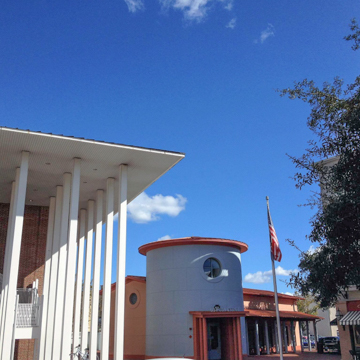Florida boasts two of the country's most prominent attempts to employ the principles of New Urbanism at the scale of a small city. Like the panhandle town of Seaside, Celebration was built from scratch by developers committed to fostering a sense of community through careful urban design strategies. Celebration is larger and more complex than Seaside, and was created by a company, Disney, with a history of developing urban-scale utopian projects in Central Florida, such as EPCOT.
New Urbanism prizes legibility in architectural form, and in Celebration, this is manifest in a nostalgic embrace of traditional architecture, at least outwardly. Some of the most important figures in Postmodernism were commissioned to design many of the town's buildings, especially its significant civic structures. Their work frequently refers to building types found in cities in the American South.
The post office by Michael Graves, for example, makes its postal boxes accessible in an open-air loggia, which evokes the 1917 post office in St. Petersburg. However, the entrance rotunda joins the rectangular portion of the building awkwardly, and the smooth finish of its cladding makes the cylindrical space seem more like a repurposed silo than entry to a significant civic building. Nevertheless, the rotunda's exposed wood joists and the building's standing seam metal roof lend the post office a surprisingly delicate scale. Along with its neighbors, the Welcome Center and the Health Building, the post office forms the civic core of Celebration.
The Welcome Center was designed by the nonagenarian godfather of Postmodernism, Philip Johnson. The building houses a reception hall and the Celebration History Center in large red brick volume engulfed by a forest of white columns supporting a broad-eaved metal roof that splays out over the sidewalk to create spaces to take shelter from the elements. Robert A. M. Stern designed the adjacent Celebration Health Building.
Charles Moore designed the Preview Center, which was completed after his death by his partner, Arthur Andersson. Like Johnson, Moore employed a vocabulary of brick walls and metal roofs. The building features an attached observation tower wrapped by an elaborate stair. Graham Gund authored the three-story Bohemian Hotel, which looks out over the lake but also features an entrance plaza that cleverly terminates the lakefront drive. The hotel evokes the ornate wood buildings of prewar Florida cities. Cesar Pelli’s Art Deco cinema seems calibrated toward furthering the illusion that Celebration was built over numerous eras. The most imaginative building in the city center, however, is the SunTrust Bank by Robert Venturi and Denise Scott Brown, which transforms the Neoclassicism associated with banks around the turn of the century. Venturi and Scott Brown pulled the facade apart in a way similar to their museums in Seattle and London, maintaining its legibility as a classical composition but rendering it with greater depth and ironically undermining the stability of the classical elements.
Though Celebration acts like a small city, the community is not a municipality. Rather, it is administered by private real estate interests. The Disney Development Company (DDC) established the Celebration Company in the early 1990s to develop the town on eleven square miles of property west of the Walt Disney World Resort outside Orlando. In 2004, Disney sold most of its stake in Celebration to a property management company.
The Celebration Company commissioned Cooper, Robertson and Partners and Robert A. M. Stern to develop the master plan. The landscape firm EDAW designed the intricate system of park spaces woven into the city plan. The Celebration master plan anticipates a community of up to 20,000 inhabitants (the current population is nearly 8,000). Celebration broke ground in 1994. A year later, nearly 5,000 hopeful applicants participated in the lottery held by Disney to sell the first 474 houses.
The planners found inspiration in cities throughout the American South, whose downtown districts demonstrated the kind of scale and mix of programmatic uses that promote walkability and a sense of community. They studied New Orleans, Savannah, and Charleston, in particular, and urged the architects to build specific buildings to look to the full range of architectural styles—Greek Revival, Second Empire, Neoclassical, vernacular, and so on—to give Celebration a sense of diversity and heritage that belies its young age. The planners organized Celebration into districts centered on squares and connected by tree-lined boulevards, and produced a form-based code that specified the building materials, finishes, colors, plant materials, and other formal elements that could be employed in the city. Graphic designer Michael Bierut of Pentagram designed the signage for the city (including its manhole covers), which uses the Bertram Goodhue–designed Cheltenham typeface.
Celebration has fascinated scholars of the urban environment since it was first proposed. Andrew Ross spent a year living there, and documented his experiences in the book The Celebration Chronicles. Douglas Frantz and Catherine Collins also used first-hand observations of the city to write their book, Celebration, U.S.A. The stage-set quality of the city’s architecture and its association with Disney have made Celebration a popular target for critics of New Urbanism. The band Chumbawamba satirized the saccharine nostalgia underlying the town’s conception in the song "Celebration, Florida" on their 2000 album WYSIWYG. However, Celebration has also found critical success in the planning community; the Urban Land Institute named the city its "New Community of the Year" in 2001.
References
Frantz, Douglas, and Catherine Collins. Celebration, U.S.A.: Living in Disney's Brave New Town. New York: Henry Holt, 2000.
Ross, Andrew. The Celebration Chronicles: Life, Liberty, and the Pursuit of Property Value in Disney's New Town. New York: Ballantine, 2000.














